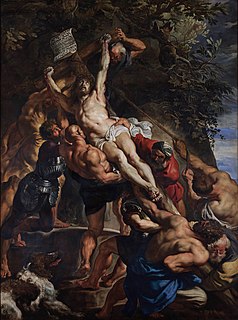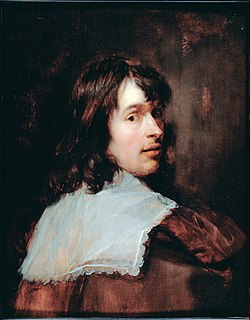
The Flemish Movement is the political movement for greater autonomy of the Belgian region of Flanders, for protection of the Dutch language, for the overall protection of Flemish culture and history, and in some cases, for splitting from Belgium and forming an independent state.

Jan van Beers was a Belgian poet born in Antwerp. He is usually referred to as "van Beers the elder" to distinguish him from his son, Jan van Beers (1852–1927), the painter.

Jan Frans Willems, Flemish writer and father of the Flemish movement.
Het Laatste Nieuws is a Dutch language newspaper based in Brussels, Belgium. It was founded by Julius Hoste Sr. on 7 June 1888. It is now part of De Persgroep, and is the most popular newspaper in Flanders and Belgium.

Paul van Ostaijen was a Belgian poet and writer.
Flemish literature is literature from Flanders, historically a region comprising parts of present-day Belgium, France and the Netherlands. Until the early 19th century, this literature was regarded as an integral part of Dutch literature. After Belgium became independent from the Netherlands in 1830, the term Flemish literature acquired a narrower meaning and refers to the Dutch-language literature produced in Belgium. It remains a part of Dutch-language literature.
Frans Jozef de Cort, was a Flemish writer. Professionally he was, first a clerk, editor, bookkeeper for a shipping company, and in 1861 a secretary at the military court.

Julius Ludovicus Maria Sabbe was a Flemish publisher and an active member of the Flemish movement. From 24 September 1869 on, he taught Dutch at the Koninklijk Atheneum of Bruges.
Jozef van Hoorde was a Flemish writer. He first went to the local school (stadsschool) and then to high school at the Koninklijk Athenaeum in Ghent.
Julius De Vigne was a Belgian lawyer, politician and writer. He studied law at the University of Ghent and established himself as a lawyer. For several years, he was a member of the provincial - and municipal Council of Ghent. As a student at the university, he contributed to the student almanacs, published by the Flemish literary student organization 't zal wel gaan. When the Flemish weekly Het Volksbelang was founded by Julius Vuylsteke, in 1867, he was one of the editors together with Julius Sabbe, Jozef Van Hoorde, and Adolf Hoste.

Maurits Karel Maria Willem Sabbe was a Flemish writer. He was a son of Julius Sabbe and the eldest of seven children. He married Gabriëlla De Smet.

Maerten de Vos, Maerten de Vos the Elder or Marten de Vos was a Flemish painter mainly of history paintings and portraits. He became, together with the brothers Ambrosius Francken I and Frans Francken I, one of the leading history painters in the Spanish Netherlands after Frans Floris’ career slumped in the second half of the sixteenth century as a result of the Iconoclastic fury of the Beeldenstorm.

Pieter van Lint or Peter van Lint (1609–1690) was a Flemish painter, draughtsman and designer of tapestries. He excelled in history paintings, genre scenes and portraits in the Flemish Baroque style with some Classisizing influence. He worked in Antwerp and Italy.

Simon de Vos was a Flemish painter, draughtsman and art collector. He started his career making small-format cabinet pictures of genre scenes, in particular of Caravaggesque merry companies. Later he switched to history painting, working on larger formats in a Flemish Baroque style which was influenced by Rubens and van Dyck.

Flemish Baroque painting refers to the art produced in the Southern Netherlands during Spanish control in the 16th and 17th centuries. The period roughly begins when the Dutch Republic was split from the Habsburg Spain regions to the south with the Spanish recapturing of Antwerp in 1585 and goes until about 1700, when Habsburg authority ended with the death of King Charles II. Antwerp, home to the prominent artists Peter Paul Rubens, Anthony van Dyck, and Jacob Jordaens, was the artistic nexus, while other notable cities include Brussels and Ghent.

Jan Cossiers was a Flemish painter and draughtsman. Cossiers’ earliest works were Caravaggesque genre works depicting low life scenes. Later in his career he painted mostly history and religious subjects as well as portraits. Cossiers was one of the leading painters in Antwerp after Rubens’ death in 1640 and one of the most original colorists in 17th-century Flanders.

Jan Blockx was a Belgian composer, pianist and teacher. He was a leader of the Flemish nationalist school in music.

Carel van Savoyen or Carel van Savoy (1620/21–1665) was a Flemish painter, draughtsman and printmaker who was active in Antwerp and Amsterdam. He is mainly known for his history paintings and portraits but he also painted allegories and genre scenes.
Juliaen Teniers or Juliaan Teniers was a Flemish painter and one of the members of the extended Teniers family of painters.

















